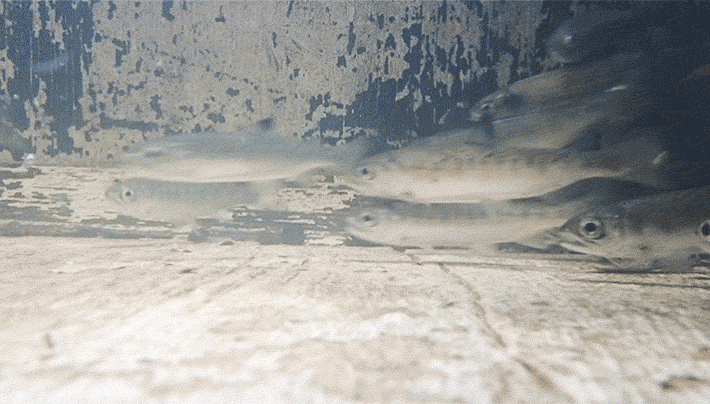Last updated: June 13, 2023
Article
The Mystery of Migration: Salmon Monitoring at Redwood Creek

NPS / Environment for the Americas / Avani Fachon

NPS / Environment for the Americas / Avani Fachon
May 2023 - Species migration has always intrigued me. From gazing at arrow-shaped formations of Canada Geese soaring above my bedroom window, to reading about monarch butterflies’ three-thousand-mile flights in my second-grade classroom, to last summer when I felt awe holding a Colorado barn swallow which had migrated to South America, and back — migration’s mystery enchants. I am enamored by how, generation after generation, organisms find unique ways to forge paths ahead with an unwavering determination to thrive. This wonder surfaced once again, as I stood on Redwood Creek, buckled into a baggy pair of waders and peering into the opening of a wooden trap. Inside, a school of jewel-like silvery coho salmon (Oncorhynchus kisutch) darted around the enclosure.
I spent the day with Mike Reichmuth, fisheries biologist with the San Francisco Bay Area Inventory & Monitoring Network (SFAN), and the salmonid team. We were near to the Muir Beach estuary (Golden Gate National Recreation Area), where Redwood Creek meets the Pacific Ocean. Upon arriving at the field site, I was impressed by a large black net spanning the width of Redwood Creek. Water, fish, and amphibians funneled into a long PVC pipe, and finally, into the trap. Salmons’ wide eyes scanned the freshwater, on high alert as they sensed currents and vibrations of the stream. As the school glided around the box — avoiding the field team’s net — each small movement was a synchronized, collective dance. I stood witness to the salmons’ mutual determination to follow their seasonal memory and trace their ancestors' paths. It felt special getting a glimpse into their fishy universe and the momentous juncture before their journey into the wild ocean.
Mike explained that these little gleaming creatures are endangered. Their populations have dropped to just 1% of historic levels due to a wide variety of stressors that affect their health and intrinsic migratory cycles. Stressors include overfishing, urban development, degraded water quality from agricultural and logging practices, and changes in ocean and climatic conditions. But still, the salmon persist with each generation, tracing their ancestors’ routes time and time again.

NPS / Environment for the Americas / Avani Fachon

NPS / Environment for the Americas / Avani Fachon
To track these salmon populations and inform restoration efforts, Mike and his team collect data for the SFAN’s Salmonid Monitoring Program. From mid-March to the end of May, they monitor salmon “smolts” (i.e. a stage in the salmons’ life cycle in which they adapt their bodies to tolerate salty ocean water). The smolts will live in the ocean for about eighteen months, after which they will, with any luck, return to their natal stream to spawn. I watch as the field team makes a small incision into each fish and inserts a passive integrated transponder (PIT) tag containing a unique number identifier. When further monitoring of this cohort occurs in the winter of 2024-2025, these tags will allow them to determine which individuals have returned as adults.
Data from past years has revealed that the salmon have an average survival rate of around 2%, which means that very few of the smolts in the creek this year will come back to spawn. Mike has noticed that this year at their Olema Creek field site (Point Reyes National Seashore), the salmon are bigger. This is hopeful for their prospects in the ocean, where their larger size and energy from stored fat will allow them to fight through the unforgiving ocean currents. Restoration projects on Redwood Creek are taking place to provide a better habitat for the salmon, allowing them to become bigger and healthier for their migration into the ocean— which will hopefully increase their return rates.
I felt grateful for the opportunity to observe the coho during this stage of their migratory journey, and to indulge my life-long wonder at migration. After the field team finished all their measurements, I released the bucket of salmon downstream, wishing them luck on their journey as they swam determinedly towards the wide ocean.
For more information
- San Francisco Bay Area Network Salmonid Monitoring webpage
- Pacific Coast Science & Learning Center Coho Salmon & Steelhead Trout webpage
- For more information on salmonid monitoring, contact Mike Reichmuth
See more from the Bay Area Nature & Science Blog
Tags
- golden gate national recreation area
- muir woods national monument
- point reyes national seashore
- sfan
- blog
- san francisco bay area
- marin county
- california
- inventory and monitoring
- inventory and monitoring division
- fish
- salmon
- coho salmon
- salmon smolt
- smolt trapping
- smolts
- migration
- redwood creek
- mosaics in science
- avani fachon
